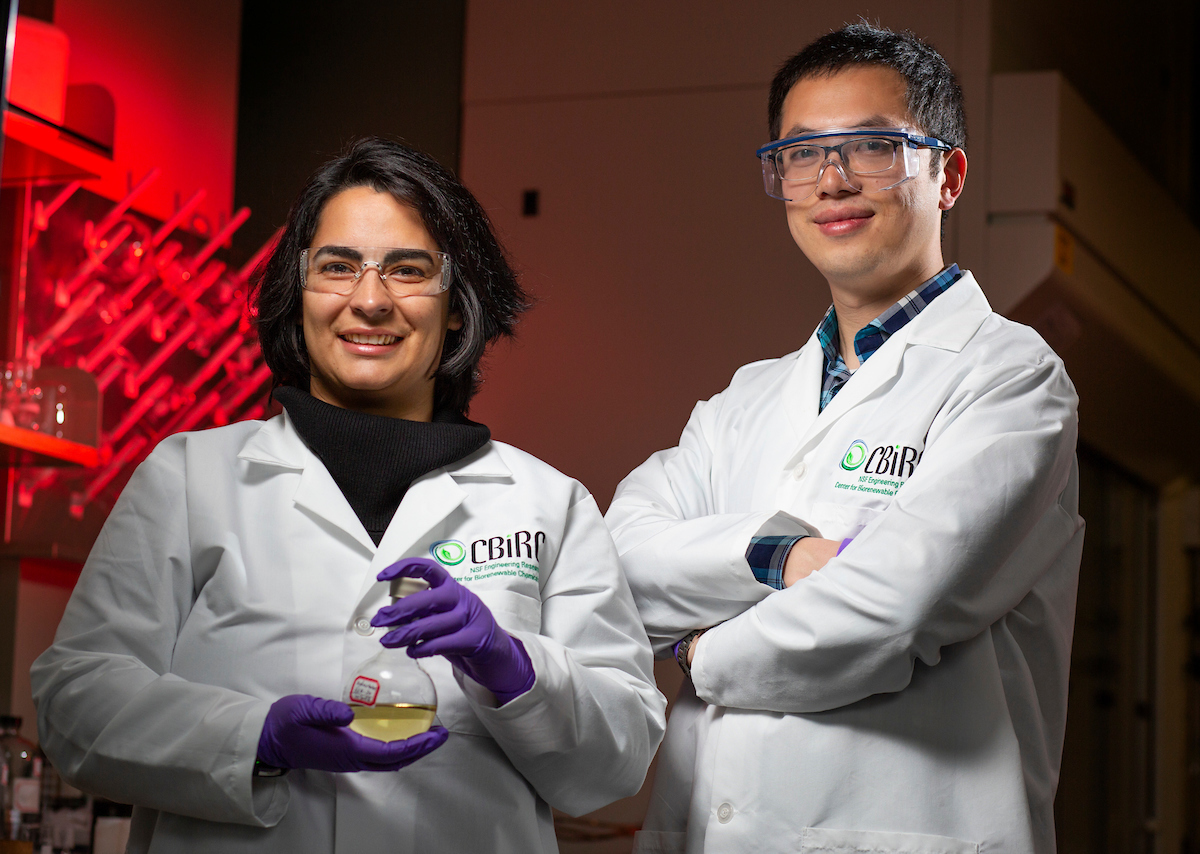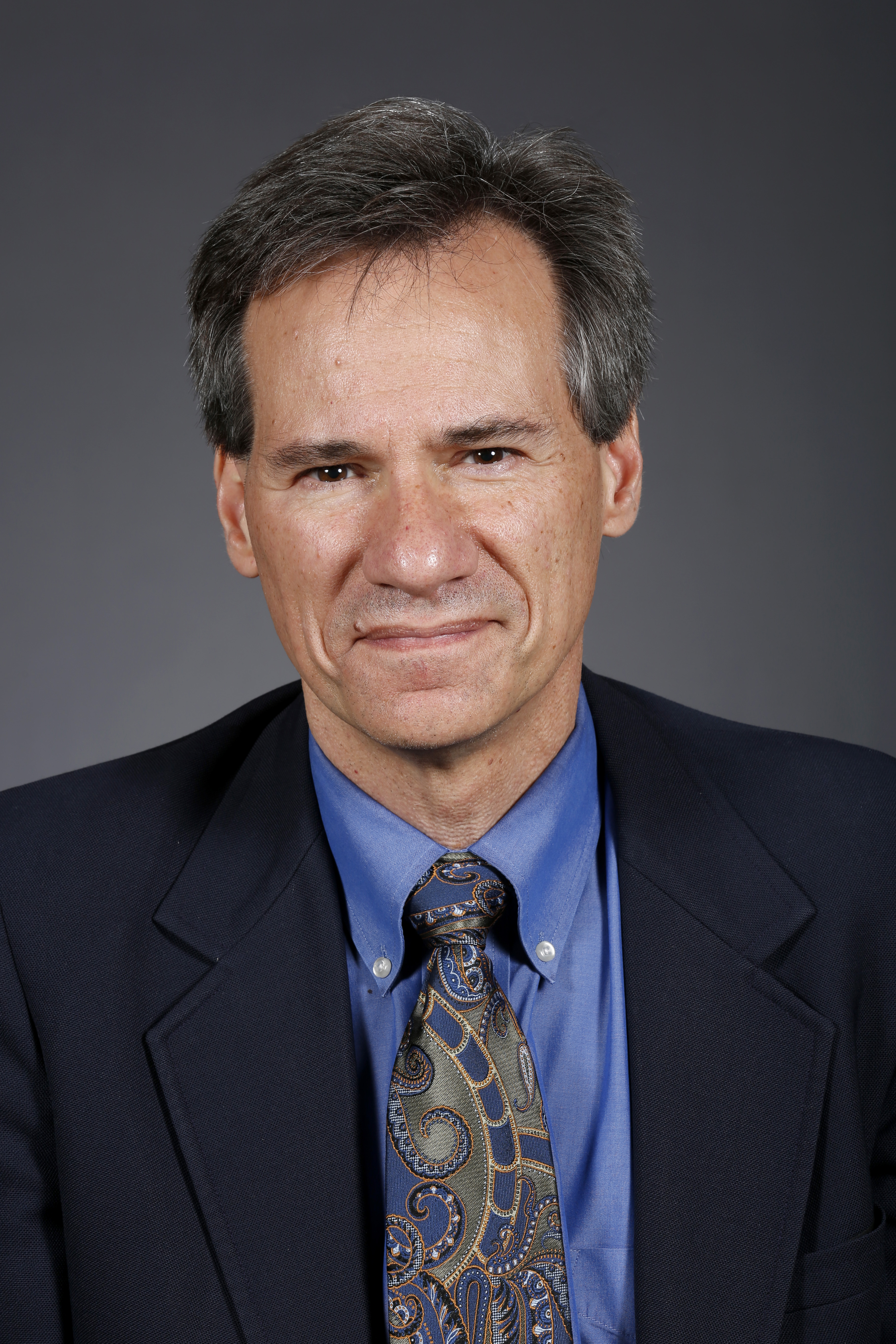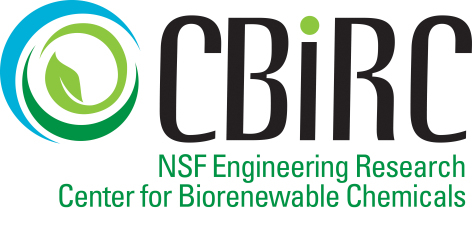
Iowa State graduate students Sanaz Abdolmohammadi, left, and Jiajie Huo are part of a research team working to develop a comprehensive system for producing biobased chemicals. Larger photo. Photo by Christopher Gannon.
AMES, Iowa – Researchers will test a new way of producing biobased chemicals that’s backed by 10 years of working in laboratories, partnering with industries and launching startups.
The researchers’ work is based on the concept that certain “bioprivileged molecules” have unique properties and can be efficiently converted to chemical products. The idea is one result of a decade of studies by the National Science Foundation Engineering Research Center for Biorenewable Chemicals (CBiRC) based at Iowa State University.
Researchers will test the idea with a three-year, $2.5 million grant from the U.S. Department of Energy’s Bioenergy Technologies Office. The recently announced grant will support development of a complete, start-to-finish system for identifying biological-derived molecules that can lead to new chemical products – in this case, anti-corrosive or flame-retardant chemicals.
“This is the alpha test for our concept,” said Brent Shanks, the director of CBiRC, an Iowa State Anson Marston Distinguished Professor in Engineering and the Mike and Jean Steffenson Chair in Chemical and Biological Engineering and leader of the research project.
In addition to Shanks, the research team includes George Kraus, a University Professor of chemistry at Iowa State; Jean-Philippe Tessonnier, an associate professor of chemical and biological engineering at Iowa State; Eric Cochran, a professor of chemical and biological engineering at Iowa State; Linda Broadbelt, the Sarah Rebecca Roland Professor of Chemical and Biological Engineering and the associate dean for research at Northwestern University’s McCormick School of Engineering in Evanston, Illinois; and Jim Pfaendtner, the Jagjeet and Janice Bindra Endowed Associate Professor of Chemical Engineering at the University of Washington in Seattle. Kraus, Tessonnier and Broadbelt are also faculty investigators at CBiRC.
Big data, modeling and synthesizing
Until now, the basic strategy for developing biobased chemicals has been opportunistic, Shanks said. It has been all about trying to find the molecules that could lead to one specific end product.
“Here, we’re trying to find out how we can do something more systematically than developing one product at a time,” Shanks said. “This opens up a lot of different avenues.”
It also creates a challenge: “The problem is there are millions of biological molecules,” Shanks said. “How do we identify the ones with the chemical structures that can lead to the end properties we want?”
The researchers have come up with a three-step system to find those molecules:
First, Pfaendtner will lead an effort at Washington to mine decades of scientific literature for references to anti-corrosive and flame-retardant chemicals. The data-science effort will try to identify chemical structures that contribute to those properties and could lead to commercial applications.
Second, Broadbelt will lead work at Northwestern to mathematically model the chemical structures that resist flames or corrosion. The models are expected to lead researchers to biological molecules with similar structures and properties. The models will also be the basis for a library of compounds with similar chemical structures.
And third, researchers at Iowa State will work in the lab to synthesize the molecules, develop potential products and test them as anti-corrosives and flame retardants.
The goal, according to standards set by the grant, is to identify at least five novel biobased chemicals that boost performance by at least 10 percent over commercially available products.
“I think we can get there right away,” Shanks said.
The value of novelty
Shanks and Peter Keeling, the industrial collaboration and innovation director for CBiRC, introduced the idea of bioprivileged molecules about one year ago in a perspectives article published by the journal Green Chemistry.
In their paper, Shanks and Keeling define bioprivileged molecules as chemical intermediates that come from biological sources. These intermediates can be converted to various products, including new chemicals and drop-in replacements for existing chemicals.
“What we’re talking about is novel molecules with new properties,” Keeling said at the time the paper was published. “These molecules haven’t been thought about because they weren’t possible from petrochemicals. But there could be great value in this novelty.”
One year later, Shanks said the concept of identifying bioprivileged molecules is still unique to CBiRC. The research and development supported by the Department of Energy is an important opportunity to move the concept forward. The concept also fits a state effort to grow Iowa’s bioscience economy by advancing four industry platforms, including biobased chemicals.
“What we’re proposing is different,” Shanks said.
That’s the whole point of the National Science Foundation investing more than $35 million in CBiRC and its research, industry partnerships and spinoff companies.
“We’ve had 10 years to think about this,” Shanks said. “We should be at the cutting edge.”
Contacts
Brent Shanks, National Science Foundation Engineering Research Center for Biorenewable Chemicals, Chemical and Biological Engineering, 515-294-1895, bshanks@iastate.edu
Mike Krapfl, News Service, 515-294-4917, mkrapfl@iastate.edu
Quotes
“Here, we’re trying to find out how we can do something more systematically than developing one product at a time. This opens up a lot of different avenues.”
---
“We’ve had 10 years to think about this. We should be at the cutting edge.”
Brent Shanks, director of the National Science Foundation Engineering Research Center for Biorenewable Chemicals based at Iowa State
Quick look
The U.S. Department of Energy is supporting development of a new system for producing biobased chemicals that's based on the idea of "bioprivileged molecules." Researchers at the Center for Biorenewable Chemicals based at Iowa State University introduced the idea last year, saying such molecules have new and valuable properties that aren't possible from petrochemicals.

